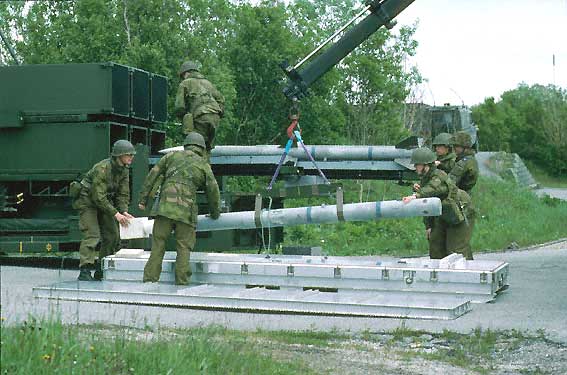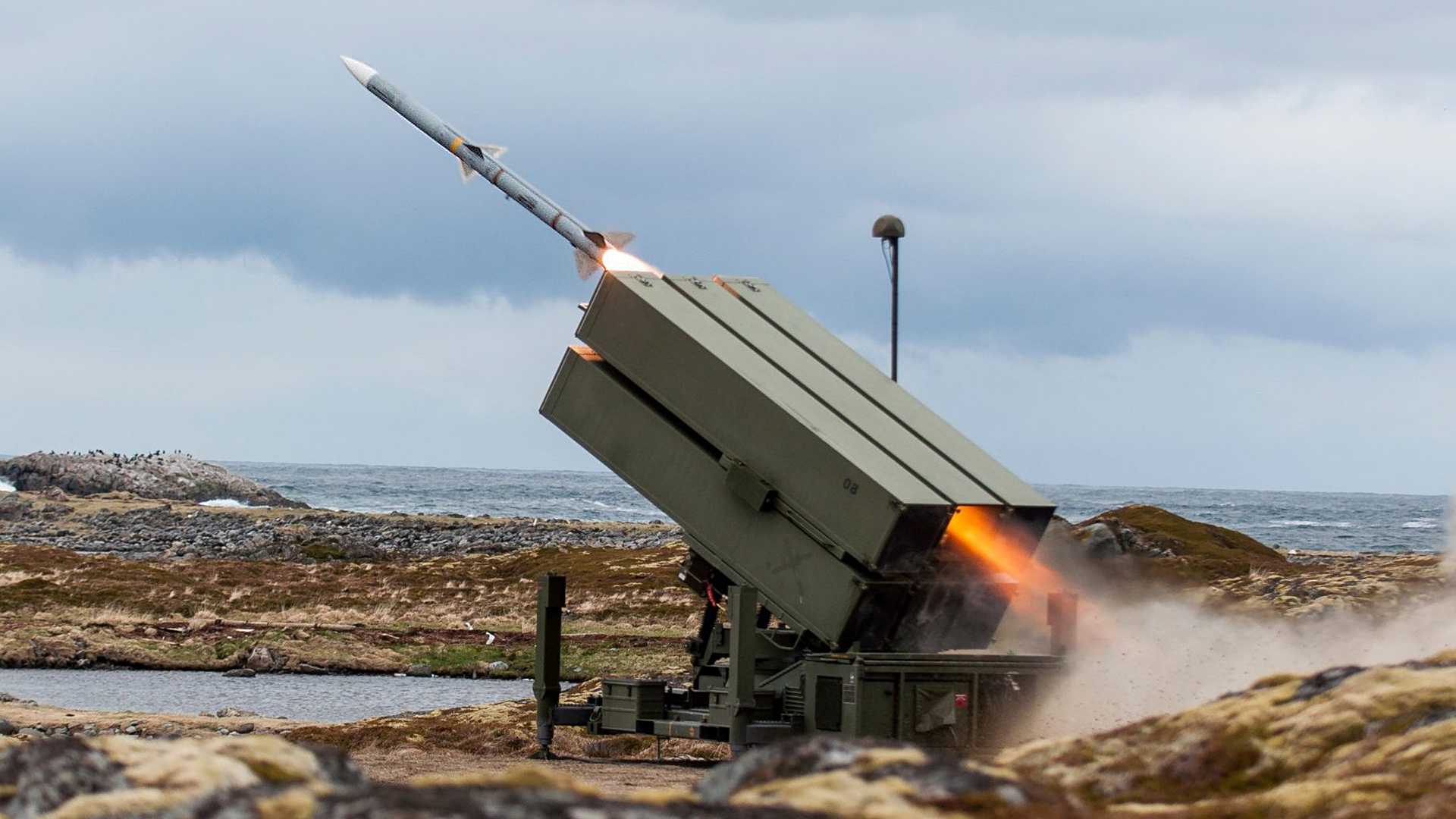When the National Advanced Surface-to-Air Missile System (NASAMS) was rumored to be in the works for Ukraine, we pointed out how one aspect of the system is uniquely suited for what Ukraine is facing. That is the massive supply of missiles for the air defense system that most NATO and allied nations can seamlessly supply Ukraine.
And it looks like Ukraine is going to need it.
It’s worth discussing this in more detail as the delivery of the first two NASAMS batteries is imminent — expedited after Russia’s large-scale missile and drone assault on major population centers in Ukraine — and donations of missiles for the system are likely to begin pouring in.
NASAMS’ primary armament is the AIM-120 Advanced Medium-Range Air-to-Air Missile (AMRAAM). Yes, the exact same missile used around the world by fighter aircraft in air-to-air applications. And no, it does not require a special AMRAAM variant or major modifications to existing missiles: NASAMS feeds off the same missile stocks as the jets.
This is an absolutely critical advantage.

This means NATO alone, which sits on an inventory of many thousands of AMRAAMs, can provide Ukraine with the ammo it needs to maximize the system’s impact. There are few modern SAM systems that have enough ammunition sitting on the shelf to last over a sustained high-intensity conflict like the one in Ukraine. The importance of this cannot be understated. Even the best air defense systems on Earth are only effective if they have the effectors (in this case missiles) required to confront threats over the course of a conflict.

Most modern surface-to-air missiles are extremely high-tech and expensive pieces of hardware that are built from advanced components that have, in many cases, long lead times to procure. AIM-120s built today cost roughly $1M a copy or more. Prices for surface-to-air missiles generally depend on the capability, maturity, the numbers they are bought in at a time, and other factors, but suffice it to say, they are all expensive. Even Israel’s Tamir interceptors used by the Iron Dome system, which are employed en-masse, usually two per target, mainly to shoot down cheap artillery rockets, cost between $40k and $100k depending on who you ask, and that’s an absolutely remarkable feat.
Once the missiles run dry, you are left with good aerial surveillance capabilities — in NASAMS’ case that includes radars, infrared search and tracking systems, and other sensors — but no weapons to actually do anything about threats that are detected. So, the fact that there are many thousands of AIM-120s in allies’ arsenals means that Russia will have a difficult time running NASAMS dry of ammunition.

There are still many older AIM-120A/Bs around that NASAMS was built to use that are aging out anyway, so giving them to Ukraine would be a very logical choice as opposed to disposing of them, firing them off in training, or investing more money into sustaining them (if that’s even possible). This massive magazine depth is especially important for the type of terrifying (literally) threat Ukraine is going to be increasingly confronted with.
The AMRAAM is the most proven beyond-visual-range air-to-air missile on Earth and the most developmentally evolved — nearly 5,000 have been tested in live-fire trials and drills. When used in the ground-launched NASAMS application, it is capable of engaging targets from relatively close ranges to up to roughly 20 miles away and from around 1,000 feet to 50,000 feet. These targets include everything from cruise missiles — which it is very good at engaging — to manned aircraft, and yes, drones.

Russia is thought to be running low on its standoff cruise and ballistic missiles and it will be very hard for it to replenish its inventory domestically in any sort of timely manner due to sanctions and just the complexity of building such systems. However, long-range suicide drones are a very different story. Iran has already supplied hundreds of these weapons to Russia and it is very likely thousands more are on the way.
There are reports that thousands of additional Iranian Shahed-136s that have proven to be such a nuisance for Ukraine just weeks after their first use will eventually enter the conflict. It is very possible we will see local licensed production in Russia for these or similar Iranian-designed suicide drones in the not-so-distant future, even if that just entails assembling Iranian components. And just as we predicted months ago when the rumors that Iranian drones were being bought by Russia began to circulate, Tehran’s suicide drones are now being used as ‘vengeance weapons,’ aimed to instill fear and random chaos through sudden destruction in densely populated areas, in addition to going after military targets.
These drones are relatively cheap to make with simple components. While they don’t pack the destructive capacity of a traditional cruise or short-range ballistic missile, what they lack in punch they make up in numbers and sheer expendability.
It’s also very possible, if not probable, that Russia could turn to Iran to import large quantities of ballistic and cruise missiles, as well. You can read all about this in this recent feature of ours, but needless to say, such a move would drastically complicate the already convoluted air defense situation.
Making things worse, each drone that is shot down means Ukraine has one less surface-to-air missile and its Soviet-era SAM stocks are finite. Replacements are extremely challenging to source and the inventory that existed at the start of the war has been depleted after nearly nine months of constant combat.
And yes, the cost-exchange ratio here is very poor. An AIM-120 AMRAAM that costs at least hundreds of thousands of dollars per missile taking out a fiberglass drone that runs on a little reciprocating gas engine is a monumental mismatch. But considering the damage these suicide drones can do both in terms of lives lost and destruction of infrastructure and property, there is no choice — they must be intercepted if they are deemed a threat. And costly missiles go very fast when confronting such a threat. Just ask Saudi Arabia which has repeatedly run its missile stocks dry — including its once plentiful AIM-120 AMRAAAM inventory — dealing with drones and low-end cruise missiles. And this was against an Iranian proxy rebel group, not a peer state with the resources of Russia.
NASAMS has another trick up its sleeve just in case Ukraine burns through AIM-120 too fast — effector flexibility. What this means is that more recent configurations can also fire the AIM-9X Sidewinder — thousands of which are also in allies’ stockpiles — as well as the IRIS-T SLS — also an adapted air-to-air missile. Ukraine is already receiving a number of IRIS-T SLM SAM systems from Germany, one of which has already arrived, but they fire a different variant of the IRIS-T. Regardless, the IRIS-T family of missiles does not exist in massive quantities like the AIM-120 or AIM-9X.
NASAMS can also fire the AMRAAM-Extended Range (AMRAAM-ER), which combines elements of the RIM-162 Evolved Sea Sparrow Missile and newer versions of the AIM-120 AMRAAM, making it much better adapted for surface launch and offering a longer range. But these missiles are not available in large numbers at this time.

If Ukraine starts gobbling up AIM-120 stocks, even with thousands on hard, it could lead to a rush to maximize production beyond what is already being realized across many nations’ orders. We have seen this exact situation occur multiple times before in the last eight months as arsenals are drawn down to support Ukraine’s fight against Russia.
And keep in mind, NASASMS is by no means a total solution. It is just one component of a multi-layered integrated air defense system that will need to be cobbled together as Ukraine transitions from Soviet-era air defense systems to more advanced Western ones. And targets like low-flying cruise missiles and drones are challenging to reliably intercept even for advanced air defense systems, especially without the help of an airborne and networked radar system to provide ‘look down’ surveillance. NASAMS also has limited coverage so the first systems will surely be deployed around major population centers to provide area air defense where it’s needed most. You can read all about this issue in the tweet thread linked below.
Regardless, NASAMS and its AIM-120 armament is certainly a great foundation on which to build Ukraine’s new integrated air defense system.
So, arguably NASAMS’ greatest advantage, beyond it being a very capable system — for 17 years it has been tasked with protecting Washington, D.C., for instance — is the fact that it has a very deep potential magazine of missiles to keep Ukrainian air defenders fed and Russian missiles, aircraft, and drones falling from the sky.
UPDATE:
The UK has pledged AMRAAMs to Ukraine for NASAMS.
The Netherlands is also donating $15M worth of air defense missiles. While the exact type is not disclosed, it is thought that they will be AIM-120s. We will try to confirm this and will report back if we do.
Contact the author: Tyler@thedrive.com
